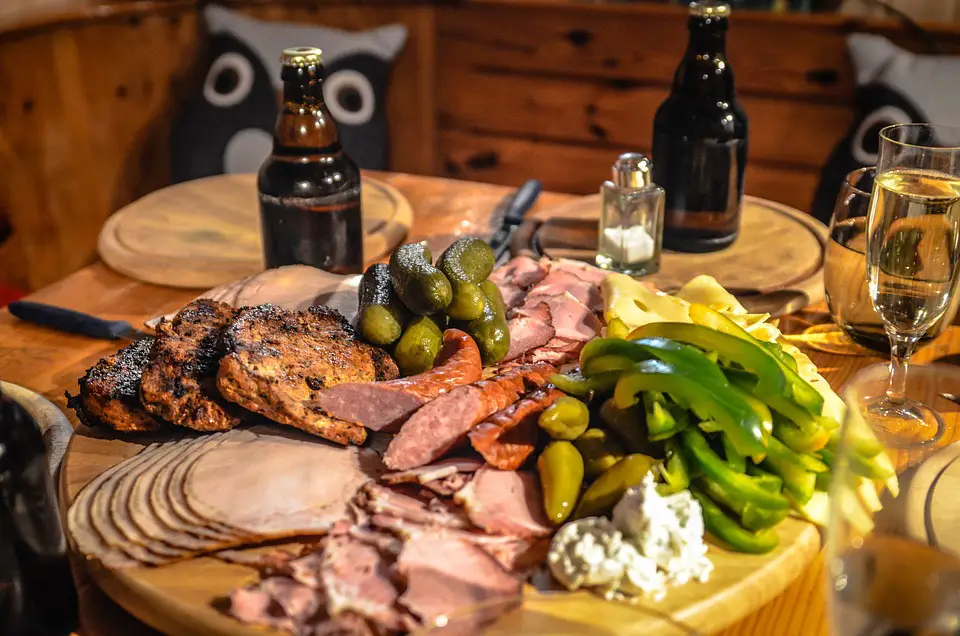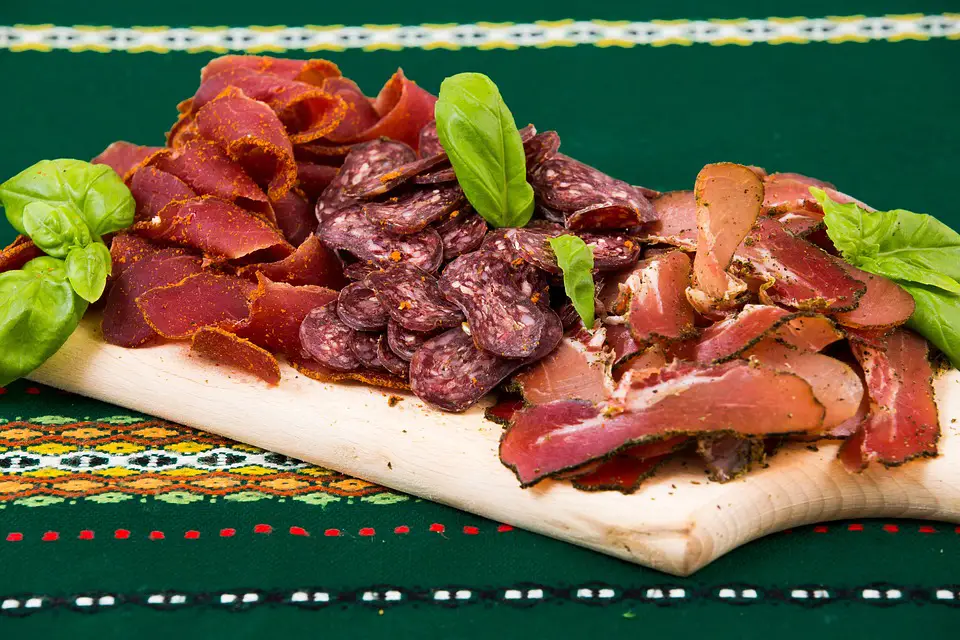Whether you’re cooking smoked ham, spiral-sliced ham, country-style ham, or another kind of ham, you’ll want to know how long cooked ham lasts. The response to that query depends on the ham’s cooking status, expiration date, and storage practices. We will examine each of the factors.

There are many signs of spoilage, but a few things that should be considered are discolouration, a bad smell, and a dull appearance. A ham may seem perfectly fine on the surface, but its interior isn’t as healthy as it should be. If it’s discoloured, mushy, or smells rancid, it’s time to toss it.
What is Ham?
Ham is produced from the rear leg of hogs, sometimes referred to as fresh ham. It can be roasted, bone-in or out, like most other pieces of meat. However, it can be pre-cured and cooked several ways to produce a prepared ham. The kind of hog used, how it is cooked or cured, and what you do with it afterwards all affect what appears on your plate.
Fresh ham can be cooked similarly to other cuts of meat in a large enough pan and oven (usually slowly roasted). Ageing, smoking and curing are the three main methods of ham preparation. Ham can frequently undergo a first precooking or curing procedure, which considerably impacts flavour.
How Long does a Cooked Ham Last in the Fridge?
Smoked Ham
Whether the ham has already been cooked affects how long smoked ham keeps in the refrigerator. Ham can keep for three to five days in the fridge on average.
Your ham can stay in the refrigerator for up to two weeks if it is still sealed in the store packaging and has not been opened.
In the refrigerator, most ham varieties last for around five days.
Leftover Spiral Ham
Given that the temperature inside the refrigerator is below 40F degrees, leftover spiral-cut ham can often be stored there for 3 to 5 days.
If the freezer is below 0F degrees, you can freeze a spiral-cut ham for between one and two months. Ham can be stored in the freezer without risk for an endless amount of time, but after two months, its quality starts to deteriorate.
What are the Tips on Cooking Ham?
Remove all of the packagings before beginning to prepare a ham. Dump any more liquid that may be present in the package’s bottom. If your ham is frozen, you must thaw it before cooking. A small piece of plastic must be thrown away on the bone on many hams.
Spiral-cut ham should be placed in a roasting pan before continuing with the method. Using a shank half ham, use a sharp knife to carve a diamond pattern across the top of the ham. Also needed is a boneless ham. This means that the glaze will have many cracks to soak through.
Buy the best ham you can afford, rather than splurging on a mass-produced ham from the supermarket. Usually, the flavour and texture are richer and meatier.
If you prefer semi-boneless meat, select bone-in ham. Don’t discard the bone! The bone imparts flavour and keeps the ham juicy. It tastes great in bean pots, broths, and pea soups. Additionally, this undiscovered component gives soups a tonne of taste.
Remember that the ham has already been cooked, and try not to overcook it. Keep the temperature low because you’ll only gently warm it in the oven. You might get rewarming instructions with your ham.
Where can I Get Ham for Cooking?
Before you can start cooking or looking for the greatest ham recipes, you must first choose the right ham for your celebration.
You may locate a selection of hams at the grocery store or butcher. For the most delicate flavour, it would be beneficial if you selected a bone-in ham. The ham will continue to be juicy and tasty because of the internal bone.
If you’re new to cooking and carving, it is suggested that you start with the ham shank cut. More easily carved. On the other hand, the butt is slightly more delicate but more difficult to cut using a carving knife.
And in case nothing else works, consult your butcher! They are there to help you choose the ideal meat for your supper.
Ham that still has the bone attached is referred to as “bone-in ham.” The enormous, traditional show-stopper, with the hock on one end and an oval-shaped ham leg on the other.
A whole ham cut in half is referred to as a half ham. Leaner and juicier than the rest of the ham, the butt, or top half, is the cut. The lowest portion of the lamb, or the shank, is fattier and more flavorful.
Semi Boneless Ham, commonly known as Easy Carve Ham, is boneless other than the centre bone (the hock/shank region).
A round, oval, or log-shaped piece of flesh is used to create a boneless ham by removing all of the bones. They are not the ideal glazing solution, but they can be used. You get 100% meat for your money, even though they may not be as stylish as bone-in ham.
Shoulder Crackle Ham: These hams should be roasted uncovered. As with a typical hog roast, the crackling ham’s rind is still visible and creates crackling.
Think of it as a ham slinky, with the bone preserving the object’s original shape. Chop the slices off the ham rather than carving it. Australia will undoubtedly experience it at some point.
It’s absolutely up to you whether or not you want it smoked. Hams can be ordered unsmoked, smoked, or triple-smoked.
Do You Cover a Ham When Baking it?
Ham or pan should be wrapped in foil. To prevent drying out, make sure the ham is properly covered. Bake the ham for 15-20 minutes, basting halfway through, in a 350-degree oven. Uncover the ham to baste it, then cover it once more before re-entering the oven.
Cook the ham as directed, with a loose foil cover, until the thermometer registers 135°F. Remove it from the oven about 20 minutes before the ham is finished. Combine the mustard, vinegar, and brown sugar in a mixing dish. By patting or brushing the mixture onto the ham, you can apply it.
Cook uncovered for an additional 20 minutes. Because cooking ham uncovered causes moisture to escape, leaving it dry and unpleasant to eat, it is better to reheat it slowly and gently.
Follow this recommendation: Put the ham on a baking dish with the sliced side until it’s time to glaze the ham, wrap it in foil or set it in a baking bag to keep it warm. The ham should be baked uncovered for 2 1/2 to 3 hours until a meat thermometer inserted into the thickest part reads 140°, basting 1/2 cup of the glaze every 30 minutes.
What are the Symptoms of Bad, Rotten, or Spoiled Ham?
Following the proper cleaning and food safety practices can prevent foodborne illnesses.
Your senses are typically the most reliable tools for detecting whether or not your ham is bad, even though they are not flawless. Poor ham is characterized by its unpleasant aroma and flat, slimy consistency. The pink tint of the meat starts to turn grey once the ham has started to rot.
Naturally, rotting items might pose certain health risks, so always remember to use good food hygiene and consume your food before its expiration date!
The signs of a ruined ham are similar to those of other types of rotting meat. If the meat has a foul smell, you should avoid eating it. Throw aside your meat if it becomes an unpleasant shade of green, grey, or black.
Mold is unlikely to grow on ham because it is generally cured; if mold appears on your meat, it’s time to abandon your science research.
You could become ill if those mold spores enter your lungs. It would help if you also refrained from sniffing any meat that has gone bad. A food item should be thrown aside as soon as you notice mold.
Take the meat out and thoroughly clean the storage container. Before throwing the meat away, cover it in a plastic bag to prevent mold spores from becoming airborne and contaminating others. That is another warning sign if your ham or other meat has a slippery, slimy texture or film coating.
The good news is that it’s typically simple to tell when your meat starts to deteriorate, even though it may do so in various ways. If some things spoil, like cheese, they can still be used. Ham and other pork products are typically not, though.
Reference: The Eternal Glory That Is Ham Hocks
Which is Better, Fresh Ham or Prepared Ham?
You can see how adaptable a pork leg may be by contrasting a fresh and cooked ham. Pork loin is significantly leaner and less moist than fresh ham, which has been seasoned and dusted with herbs before being cooked for nine to ten hours at a low temperature.
When you open the oven door, the meat will be wrapped in gorgeous golden brown, crisp packaging that acts as a sweatbox to protect and moisten it. You can peel off the package with your fingers, which will melt in your mouth.
One of the ways of preparation—brine, smoke, salt, and age—takes these fundamental characteristics in a completely different direction. However, the essence of the ham is still present, possibly even more fully realized but in a very different guise.
Conclusion
When it comes to storing cooked ham, the refrigerator can be a great place to keep the meat for two to three days. Regardless of the temperature, the ham should be wrapped in a damp towel and stored in the coolest part of the fridge. The temperature should remain below 40 degrees F. When the ham is ready to be served, slice it and return it to the towel. Keeping the ham cold will prevent accelerated bacterial growth.
If you’ve prepared ham in advance, you’ll have a better chance of keeping it for longer if you use a towel to wrap it. If you don’t have a towel, try placing it in a cardboard box or insulated cooler. To avoid spilling, place the food in a covered container with a lid or insulated ice pack.
